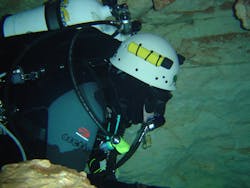Process Safety: Don’t Let Risk Management Falter
To me, cave diving represents the epitome of risk management. Each time I ventured into a cave, my life hinged on my ability to effectively manage risks. The facets of cave diving seamlessly align with all aspects of the IChemE Safety Centre Process Safety Framework. These components encompass leadership, knowledge and competence, engineering and design, systems and procedures, human factors, assurance and culture. At the heart of successful cave diving lie these fundamental prerequisites: skill, attitude, meticulous planning and top-notch equipment.
Let me take you through these core requirements:
Skill means being a competent cave diver — this is different to open-water diving. The buoyancy movement skills are very high level. Cave certification requires testing until reactions are second nature and the skill is both mental and physical. This is because cave divers must execute all skills in zero visibility and under extreme mental stress.
Attitude is about having the right culture in the dive team, positive leadership and psychological safety. We used to say, “Today is not a good day to die,” when the dive we were about to undertake didn’t feel right, and there was never any pressure to continue — a clear signal to abort that dive. While it sounds flippant, I used that phrase several times in my cave diving experience and lived to tell the tale.
Planning is centered on ensuring the effectiveness of your procedures, adhering to the principle of "plan the dive and dive the plan." Key elements within the planning phase encompass a comprehensive grasp of the site, its access and egress, air consumption estimates, dive duration, dive depth and the distance to be traversed. To aid memory, we abbreviated these vital aspects as 'SADDD,' a mnemonic that served as a reminder to account for all the essential steps. Given the complexity of these plans, it was imperative to carry a written copy during the dive to ensure no critical elements were overlooked.
Equipment encompasses a diverse array of items, addressing not only their design and arrangement for optimal functionality in challenging environments but also incorporating redundancy because one must anticipate equipment failures in worst-case scenarios. Striking the right balance between an adequate amount of redundancy and avoiding an excessive, cumbersome load was crucial, so we consistently pursued streamlined solutions. Following this, all equipment underwent assembly and meticulous checks, a collaborative effort between myself and my dive buddy, ensuring every component functioned precisely as required.
The arrangement of equipment represented a human factors challenge. It necessitated the ability to access and utilize every piece of gear, even in conditions of zero visibility, emphasizing the need for a meticulously planned layout that allowed for immediate access at all times.
I have since retired from the world of cave diving, a pursuit that took me to some of the most remote and extreme caves on Earth. So, what prompted my retirement? As I mentioned earlier, cave diving represented the ultimate in risk management for me. Prior to each dive, I was acutely aware there was no search and rescue safety net available. As my life's priorities evolved, so did my tolerance for risk. When I was single, with prudent risk management, I found the level of risk acceptable. However, as I started a family, my risk tolerance underwent a transformation. This serves as a compelling illustration of how a deep understanding of the risks we encounter, coupled with established risk tolerance criteria, empowers us to make informed decisions, both in our professional endeavors and personal lives.
About the Author
Trish Kerin, Stay Safe columnist
Director, Lead Like Kerin
Trish Kerin is an award-winning international expert and keynote speaker in process safety. She is the director of Lead Like Kerin Pty Ltd, and uses her unique story-telling skills to advance process safety practices at chemical facilities. Trish leverages her years of engineering and varied leadership experience to help organizations improve their process safety outcomes.
She has represented industry to many government bodies and has sat on the board of the Australian National Offshore Petroleum Safety and Environmental Management Authority. She is a Chartered Engineer, registered Professional Process Safety Engineer, Fellow of IChemE and Engineers Australia. Trish also holds a diploma in OHS, a master of leadership and is a graduate of the Australian Institute of Company Directors. Her recent book "The Platypus Philosophy" helps operators identify weak signals.
Her expertise has been recognized with the John A Brodie Medal (2015), the Trevor Kletz Merit Award (2018), Women in Safety Network’s Inaugural Leader of the Year (2022) and has been named a Superstar of STEM for 2023-2024 by Science and Technology Australia.


